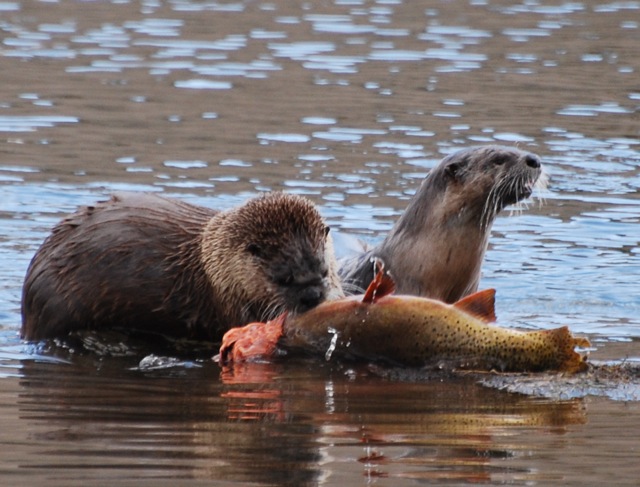 Bison family in Yellowstone (photo by Beth Pratt)In Yellowstone National Park, wildlife is in abundance—herds of bison roam across the landscape, the howling of wolves echoes across the canyons, and grizzly bears wander in the forests.
Bison family in Yellowstone (photo by Beth Pratt)In Yellowstone National Park, wildlife is in abundance—herds of bison roam across the landscape, the howling of wolves echoes across the canyons, and grizzly bears wander in the forests.
What better place to celebrate National Wildlife Week?
National Wildlife Week, March 14-20, is the longest running program of the National Wildlife Federation and has been held each year since 1938. Past spokespeople of National Wildlife Week include Walt Disney, Shirley Temple, and Robert Redford. This year’s event also marks the 75th anniversary of National Wildlife Federation (NWF) itself. In celebration, children, youth and adults are taking time to celebrate the wildlife that move us by exploring how wildlife fly, climb, leap, swim and dig.
“Through National Wildlife Week, we can learn more about the wildlife around us and some of the unique ways they move and how we can help them. Taking time to go outdoors and be out there in nature helps to re-connect us to our local environment. Kids today are wired and on the go much of the day, so many miss the leaping robin or the ant on the sidewalk. Taking 15 minutes to go outside can lead to a life-time of environmental stewardship,” says Eliza Russell, Director of Education for NWF.
Although home to the more popular mega-fauna like bears, bison and wolves, Yellowstone has an abundance of other creatures, with a species count of 67 mammals, 322 birds, 16 fish, 6 reptiles, and 4 amphibians. In keeping with NWF’s daily theme for the week, here’s an introduction to wildlife in Yellowstone that:
Fly: The elegant Trumpeter Swan—the largest waterfowl in the world with a wingspan of up to 7 feet—can be seen flying gracefully over Yellowstone. Once on the verge of extinction, the population now appears to be stable. More Yellowstone wildlife that fly.
Climb and Dig: The pocket gopher is a prodigious digger. A single animal’s tunnel system can extend to over 500 feet in length and contain separate chambers for food storage, nesting sites, fecal deposits, and foraging access. And it achieves all of this remarkable burrowing with tiny front claws that measure only an inch in length. More Yellowstone wildlife that can climb and dig. River otters with cutthroat trout (Photo by Beth Pratt)Swim: Yellowstone’s river otters swim playfully in Yellowstone Lake and in the park’s many rivers as they search for a meal of trout. The largest members of the weasel family, they can weigh up to 30 pounds. More Yellowstone wildlife that can swim.
River otters with cutthroat trout (Photo by Beth Pratt)Swim: Yellowstone’s river otters swim playfully in Yellowstone Lake and in the park’s many rivers as they search for a meal of trout. The largest members of the weasel family, they can weigh up to 30 pounds. More Yellowstone wildlife that can swim.
Hop and Leap: Only two species of frogs live in Yellowstone—the boreal chorus and the Columbia spotted frogs. Boreal chorus frogs can be heard in wetlands each year in the spring singing loudly for a mate—the frog almost doubles its body size as it calls up to twenty times per minute. More Yellowstone wildlife that can hop and leap.
Run and Crawl: Pronghorn are the fastest land mammals in North American and can sprint up to 50 mph. A newborn can outrun a human within a couple days of birth. More Yellowstone wildlife that can run and crawl.
 Pronghorn running--the animals can sprint up to 50 mph (Photo by Beth Pratt)But you don’t need to visit Yellowstone to celebrate National Wildlife Week. Wildlife lives all around us, in our neighborhoods, communities, and parks. Take part in the celebration by participating in Wildlife Watch or organizing a volunteer project for wildlife in your community. Visit www.nwf.org/nationalwildlifeweek to get started and download a watch list and learn more about the featured wildlife. During National Wildlife Week there will be free downloadable posters with wildlife trading cards for each week day.
Pronghorn running--the animals can sprint up to 50 mph (Photo by Beth Pratt)But you don’t need to visit Yellowstone to celebrate National Wildlife Week. Wildlife lives all around us, in our neighborhoods, communities, and parks. Take part in the celebration by participating in Wildlife Watch or organizing a volunteer project for wildlife in your community. Visit www.nwf.org/nationalwildlifeweek to get started and download a watch list and learn more about the featured wildlife. During National Wildlife Week there will be free downloadable posters with wildlife trading cards for each week day.
Founded in 1936, National Wildlife Federation’s mission is to inspire Americans to protect wildlife for our children’s future. The organization is currently developing programs to counteract nature deficit disorder in children by encouraging parents and other caring adults to help children spend more time outdoors everyday. Learn more at www.nwf.org.
